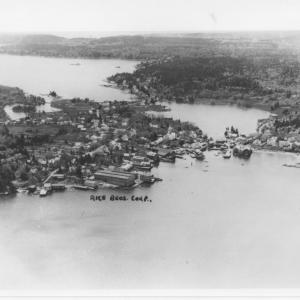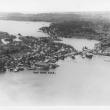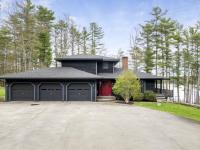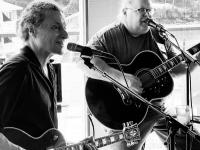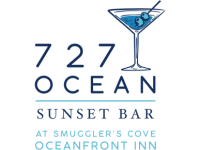East Boothbay's 1910s Secession Attempt, Part II
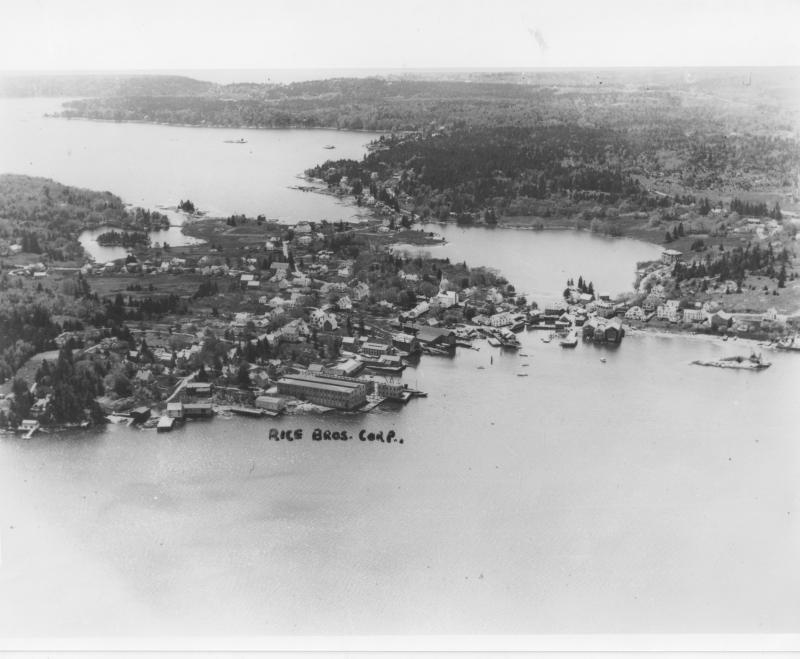 An aerial view of the village of East Boothbay, circa 1936. The millpond is on the right; the small pond on the left is The Marsh between Murray Hill and Paradise Point. In the foreground, the 1936 shipyards arc around the little harbor: Rice Brothers (now Washburn & Doughty), Bernard Rice (now Shipbuilders Park), Goudy & Stevens (now Hodgdon Yachts), and lastly Hodgdon Brothers (now Ocean Point Marina) which is just right of the millpond's outlet. The neck between Linekin Bay and the mill pond keeps the peninsula that extends four miles from the mill pond to Ocean Point from being an island. Courtesy photo
An aerial view of the village of East Boothbay, circa 1936. The millpond is on the right; the small pond on the left is The Marsh between Murray Hill and Paradise Point. In the foreground, the 1936 shipyards arc around the little harbor: Rice Brothers (now Washburn & Doughty), Bernard Rice (now Shipbuilders Park), Goudy & Stevens (now Hodgdon Yachts), and lastly Hodgdon Brothers (now Ocean Point Marina) which is just right of the millpond's outlet. The neck between Linekin Bay and the mill pond keeps the peninsula that extends four miles from the mill pond to Ocean Point from being an island. Courtesy photo
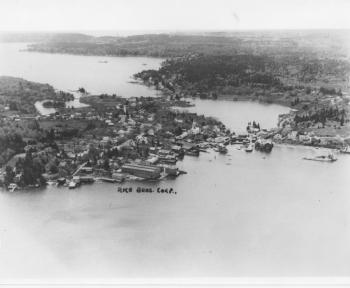 An aerial view of the village of East Boothbay, circa 1936. The millpond is on the right; the small pond on the left is The Marsh between Murray Hill and Paradise Point. In the foreground, the 1936 shipyards arc around the little harbor: Rice Brothers (now Washburn & Doughty), Bernard Rice (now Shipbuilders Park), Goudy & Stevens (now Hodgdon Yachts), and lastly Hodgdon Brothers (now Ocean Point Marina) which is just right of the millpond's outlet. The neck between Linekin Bay and the mill pond keeps the peninsula that extends four miles from the mill pond to Ocean Point from being an island. Courtesy photo
An aerial view of the village of East Boothbay, circa 1936. The millpond is on the right; the small pond on the left is The Marsh between Murray Hill and Paradise Point. In the foreground, the 1936 shipyards arc around the little harbor: Rice Brothers (now Washburn & Doughty), Bernard Rice (now Shipbuilders Park), Goudy & Stevens (now Hodgdon Yachts), and lastly Hodgdon Brothers (now Ocean Point Marina) which is just right of the millpond's outlet. The neck between Linekin Bay and the mill pond keeps the peninsula that extends four miles from the mill pond to Ocean Point from being an island. Courtesy photo
As mentioned last time, the town of Boothbay, incorporated in 1764, stayed intact until 1842 when Cape Newagen Island, now Southport, left. Next to leave was Boothbay Harbor in 1889. Other parts of town made serious attempts to part ways as well, including Damariscove in 1885 and East Boothbay in the 1910s. This article covers East Boothbay's attempt.
Grumblings
I believe the village's formal attempt to secede began in earnest in 1910. Its traditional bounds, defined by school and highway districts, extended from Perch Island Cove and the Farnhams Point turn on Route 96 north up the Damariscotta River to a little above Meadow Cove. The village was thriving, with multiple shipyards, the summer colonies of Paradise Point and Murray Hill within its immediate bounds, and half a dozen stores. Summer colonies Bayville and Ocean Point were nearby, as well as Linekin factory sites. The village residents had formed a Board of Trade to promote the benefits of their neighborhood and were confident that progress was boundless. East Boothbay felt that its outsize contribution to town taxes was not being respected and its wishes were too easily ignored by the rest of the town.
A committee was formed in 1910 to pursue separation. It included George M. Hodgdon of Hodgdon Brothers shipyard and his nephew Tyler Hodgdon of the tidemill across the village bridge. The yard and mill were one business entity from about 1826, when the first Caleb Hodgdon came to town, to 1896 when they parted ways. Tyler's father Caleb Jr. took the mill and George M.'s three older sons took the shipyard. Both entities were heavy taxpayers, as were other men on the committee. I believe the secession effort initially included the heavy taxpaying areas: the village and south to Ocean Point. Eventually I believe it reached north to Bryer's Neck, a complete nine-mile slice from north to south of the east quarter of town, including 10 of the town's 25 miles. Perhaps the state demanded a certain expanse to pursue separation, so the northeasterly Back Narrows and Pleasant Cove area was pulled in.
The Meat of the Matter
Reading the surviving accounts, I realized the core problem was that while East Boothbay, Linekin, and Ocean Point provided more than half the town taxes with shipyards, summer residents, and businesses, they occupied only about a sixth of the town's footprint. With the east section's 202 residents of the town's 525, it could always be outvoted, yet its perceived needs differed from those of the rural residents. No other part of town had any sizable shipyards nor so many seasonal residents, taxpayers without a voice.
At the hearing in Augusta in mid-February the arguments were heard and were carried for two weeks in the Register. The February 18 Register listed the testimony of those in favor of division. First it was explained there were no hard feelings, "but geographic, social, political, and business conditions made the division necessary." Lyman McDougall complained that townspeople from other parts of town didn't come to East Boothbay. According to him, most of the travel was by boat rather than roads, so division was natural, like an island. In fact, the peninsula from the mill pond to Ocean Point is only prevented from being an island by the little neck near the Murray Hill boat ramp. He finished by saying that division would let them get what they wanted unimpeded by contrary voters who could always outvote them.
Local Men Speak Up
Henry Rice said he hadn't been to town meeting in 10 years because the eight-mile distance over and back was too far to walk; and if they showed up, they could only get what the old town gave them. On cross-examination, he admitted they'd gotten what they wanted at recent prior town meetings (their own polling place was an exception to that). Coal dealer Osgood Vannah testified he'd had only one sale to a Boothbay person in years, and he too felt outnumbered at town meeting.
Alfred Dodge mentioned the selectman and road commissioner from the eastern section hadn't attended the meeting because they feared if division failed, they wouldn't be reelected. He continued that the village roads were in bad shape through neglect and their upkeep cost twice that of the west.
Howard McDougall criticized the village's inability to maintain a standard high school (it, like Boothbay Center and Barters Island, had a two-year high), and having to pay tuition to Lincoln Academy for students' complete education. Henry McGunigle pointed out that the village paid almost 60 percent of town taxes, but got back only $5,000 of the town's $14,000 tax total in 1909. And he highlighted the summer people of East Boothbay who paid 44 percent of the whole town taxes.
Lastly Victor Montgomery said he didn't think the first selectman had ever been in East Boothbay. And he acknowledged that some of the reasons might seem petty, but they did retard East Boothbay's progress. Victor made a good point; most of the arguments don't seem to rise to a breakup level.
Event Date
Address
United States

